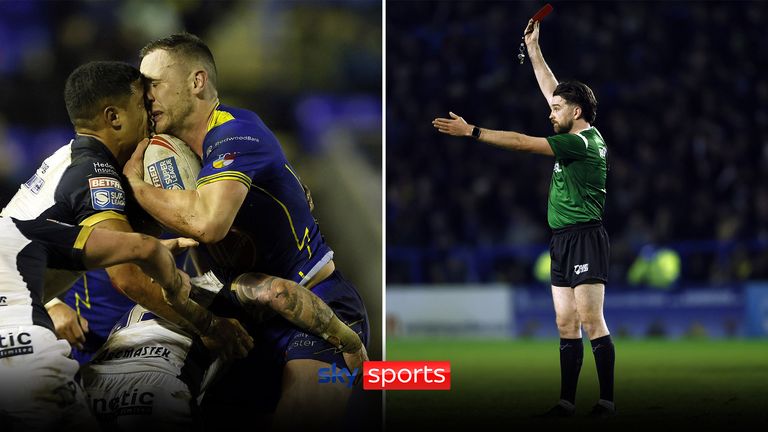Head of match officials Phil Bentham spoke to Sky Sports’ Megan Wellens to discuss the uptick in red and yellow cards, the pace of video referee calls, and Captain’s Challenge…
We have seen a big increase in the number of cards being shown in Super League over recent weeks. Is that something that has happened naturally?
I think at the beginning of the season there was less head contact than we’re currently seeing that is sanctionable. I think we have got certainly one that we gave a red card that should have been a yellow at Leeds (to Sauaso Sue) – and in making that comment, I think it’s important we bear in mind the range of considerations for video referees in a short period of time, with the sport’s focus on the importance of player welfare.
But other than that, it’s worked in a cycle where we’ve ended up with a lot more incidents recently that have occurred that require a sanction.
I think the difficulty with the framework that works like this is that it has to be applied to every different incident and none of the incidents are exactly the same.
So we try and use the framework, we try and use the considerations within the framework to make sure that we’re as consistent as possible on incidents which are by their own nature inconsistent.
So, it is a difficult thing to try and apply but the amount of work that we do looking at every single high tackle as a group to try and make sure that we are consistent in our application of it and for us, from my opinion, it’s gone incorrect on one occasion – and again, I think it’s important to stress the reasons that might have been behind that.
When we have reviewed it afterwards we felt that it didn’t reach the threshold for high-level force, a subjective measure, and therefore it should have remained a yellow card with that being the mitigation.
On the Lewis Murphy incident, what is the framework being used? Can you understand why it has split opinion?
This incident does sit differently – because there’s no tackler because nobody is in possession.
This is an incident that is worked on a framework of dangerous contact which we would then potentially rule accidental, careless, reckless or deliberate.
So it does sit differently from the head contact framework which is designed to look at tacklers. So it’s important that we make that clear.
On this occasion the video referee ruled it that Murphy had a duty of care when he was jumping and leading with the knee that he can’t make contact with the head.
Murphy has made, in our view, reckless head contact. Reckless because he’s jumped leading with the knee which has hit the head of the opponent.
Now, a lot of the feedback that I’m getting from people within the game is that they felt that part of this was because the Leeds player didn’t take off for the ball.
As a group of referees, whilst we’ve got a rule on duty of care, do we have to ask if that player put himself in that position by not jumping, but in law there’s nothing to say he has to jump to catch a ball.
So, it might be something we need to look at as a group of referees to make sure that we’re in tune with where the game is.
Sometimes it can be a noisy minority, but the decision has not been met with many people supporting it so we have to look at ourselves, really, on that type of situation.
All the feedback that I’m getting is what a fantastic skill it was by Murphy to jump to that height to be able to hang in the air and if there’s some incidental contact with the Leeds player in the head that we should just view that with some common sense, and just say ‘there is contact there, but which player’s caused it is very difficult for us to decide’.
So, at worst, put it on report so that people can sit down for 20 minutes and view.
Can you understand the confusion fans and players are feeling regarding what is deemed a card?
The video referees obviously study these more than anybody and they’re the experts on the laws and the requirements of the head contact framework, without being disrespectful to the press or even the players in these incidents.
So, what they’ve got to do under the framework is they’ve got to look and they’ve got to start at a red card which is a head contact that’s forceful and dangerous.
And then they work as to whether there’s any mitigation. If there’s one mitigation, it is a sin bin and if there’s two then it would just result in the on-field penalty.
The video referee has got to make that subjective judgment on several things.
Has he lost height? Does it reach a high-level force threshold? Is he trying to make a tackle? Is there an aggravating factor?
Like the (Ash) Handley one (for Leeds against Hull KR), for example, is different to the other two as Handley tackled a player who didn’t have the ball.
All those things you have to put into the mix to try and come to what would be a consistent application of the framework.
Liam Moore received praise in the Challenge Cup semi-final when he placed a head-on-head contact by Owen Trout on report. However, this had people questioning whether they would get the same refereeing standards every week – can you understand that?
It just comes back to the consistent application of something to incidents that aren’t consistent.
If you try and compare an example of any weekend where a player got sin-binned for a high tackle as opposed to the weekend where a player has banged heads with another player, they are completely different incidents – so how do you consistently apply an outcome to that when they are completely different?
It started with the Nu Brown incident last year and we got absolutely slated for sending a player off for banging heads with another player, so we have to listen.
As I’m saying about Murphy, we have to listen to the sport and people within the sport and the other stakeholders who say [with] head-on-head contact we don’t want on-field sanctions.
That is where we are at in the moment. Unless a player drives in like a rhino with his head and cracks into somebody then head-on-head will be placed on report.
But we’re being told by the sport that ‘head-on-head contact, nobody means to do it, the responsibility lies with the defender but we don’t want to see that player receive an on-field sanction – we want that to be looked at in detail for 20-30 minutes on a Monday morning by a match review panel to decide if there’s a charge or not’.
So we have changed. We’ve changed in the last 12 months because we have listened to people and people don’t want the head-to-head sanctioned.
That’s why Liam got a lot of credit for putting it on report because ultimately that’s what people want to see.
Has the introduction of Captain’s Challenge placed pressure on the length of video refereeing decisions?
I will take responsibility, first of all, for the fact that there are occasions where we get a straightforward video ref decision, and we look at too many angles.
We review each call as a group and we’re quite forceful in our reviews and recognise we have to improve this because we’re setting the wrong narrative.
There are other occasions where video ref calls are very difficult and I wouldn’t want them to take any less time than they do because they wouldn’t be being diligent.
With Captain’s Challenge, because of the number of interventions now of the video referee, it makes it look like we’re involved too much in the game, in some people’s opinion.
We were charged with bringing in Captain’s Challenge because we have this pursuit in sport- it is the same in football, cricket, tennis – of correct officials’ decisions.
One of the downsides of that is that officials need time to look at replays and to get to correct outcomes.
Just to throw a little bit back on the players, two-thirds of Captain’s Challenges have been unsuccessful so we’ve wasted a lot of time looking at decisions that the referee got right in the first place.
On the video referee element, how much weight is the ‘try’ or ‘no try’ call from the referee meant to carry?
The official guidance to the referees and video referees is that the on-field call, the video referee can only overturn if he has sufficient evidence.
If you compare that to football, there it has to be a clear and obvious error, so our bar is lower than football.
But we have to see evidence, and the evidence has to be on the screen, so the live call does hold weight.
The best way I can explain it is that the referees are told that they must make the decision as if they were refereeing without a video referee.
That is your on-field decision and then we look at evidence to see if that is incorrect.
It doesn’t sit perfect with everybody because we all know when the ball’s hidden it’s always going to come back with the on-field call.
We get accused of ‘well you only made a guess’ but I would argue that the referee’s opinion is better than anybody else’s because he’s usually in a good position to see it.
The other option is to go back to referring to the video referee with no live call and if it’s inconclusive it would come back as try (benefit of the doubt). This is a decision for the laws committee.
Sky Sports will again show every game of Super League live this season – including two matches in each round exclusively live, with the remaining four matches each week shown on Sky Sports+ via the red button.













